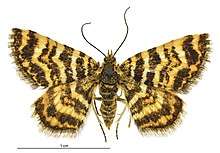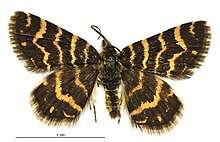Notoreas isomoera
Notoreas isomoera is a species of moth in the family Geometridae. It is endemic to New Zealand.
| Notoreas isomoera | |
|---|---|
 | |
| Female | |
 | |
| Male | |
| Scientific classification | |
| Kingdom: | Animalia |
| Phylum: | Arthropoda |
| Class: | Insecta |
| Order: | Lepidoptera |
| Family: | Geometridae |
| Genus: | Notoreas |
| Species: | N. isomoera |
| Binomial name | |
| Notoreas isomoera | |
Taxonomy
This species was first described in 1939 by Louis Beethoven Prout using material collected at Ben Lomond near Queenstown (male holotype) and at the Obelisk, Old Man Range in Otago (female allotype) by George Howes.[1][2][3] The genus Notoreas was reviewed in 1986 by R. C. Craw and the placement of this species within it was confirmed.[4] However species within the genus Notoreas are currently regarded as being in need of revision.[5] The holotype specimen is held at the Natural History Museum, London.[3]
Description
Prout described the species as follows:
22—23 mm. Very near isoleuca, so determined in the Howes collection. Pectinations of ♂︎ slightly shorter. Markings broader, yellower; forewing with median line definitely and the postmedian rather acutely angled, subterminal extremely slight except anteriorly and as a dot in cellule 3; hindwing with similar distinctions.[2]
Life cycle and behaviour
The female moth lays her eggs within the flower buds of their host plant.[7] When the larvae emerge from their eggs, they eat into the leaves or buds of their host, hiding from predators.[7] Once they are large enough, they emerge to feed from the fresh growth of the plant.[7] N. isomoera pupate in a loose cocoon on the ground under their host.[7] N. isomoera are day-flying moths.[7] They are low but fast flyers and constantly vibrate their wings to enable them to take off rapidly.[7]
Host species
The host plants for the larvae of N. isomoera are endemic species within the genera Pimelea and Kelleria.[8]
References
| Wikimedia Commons has media related to Notoreas isomoera. |
- "Notoreas isomoera Prout, 1939". www.nzor.org.nz. Manaaki Whenua - Landcare Research. Retrieved 11 December 2018.
- Prout, L. B. (1939). "Geometridae: Fauna Indo-Australica". The Macrolepidoptera of the World. 12: 237–292 – via Biodiversity Heritage Library.
- Dugdale, John S. (23 September 1988). Lepidoptera - annotated catalogue, and keys to family-group taxa (PDF). Fauna of New Zealand. 14. pp. 1–264. ISBN 978-0-477-02518-8 – via Manaaki Whenua - Landcare Research.
- Craw, R.C. (5 January 2012). "Review of the genus Notoreas (sensu auctorum) (Lepidoptera: Geometridae: Larentiinae)". New Zealand Journal of Zoology. 13 (1): 131–140. doi:10.1080/03014223.1986.10422654.
- Hoare, R. J. B; Rhode, B.E.; Emmerson, A.W. (2011). "Larger moths of New Zealand: Image gallery and online guide". Manaaki Whenua Landcare Research. Retrieved 9 December 2018.
- Gordon, Dennis P., ed. (2010). New Zealand Inventory of Biodiversity. Volume Two. Kingdom Animalia: Chaetognatha, Ecdysozoa, Ichnofossils. Vol. 2. Christchurch, N.Z.: Canterbury University Press. p. 460. ISBN 9781877257933. OCLC 973607714.
- Patrick, Brian (Autumn 2015). "Discovering New Zealand's gorgeous moths" (PDF). Butterflies and Moths of New Zealand. New Zealand: Butterflies and Moths of New Zealand Trust. p. 13. Retrieved 4 May 2018.
- Patrick, Brian (Autumn 2015). "Discovering New Zealand's gorgeous moths" (PDF). Butterflies and Moths of New Zealand. New Zealand: Butterflies and Moths of New Zealand Trust. p. 13. Retrieved 8 December 2018.